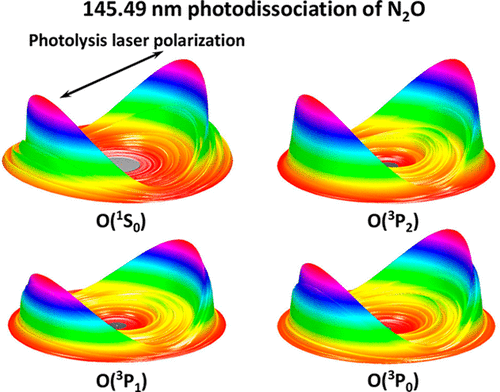当前位置:
X-MOL 学术
›
J. Phys. Chem. A
›
论文详情
Our official English website, www.x-mol.net, welcomes your
feedback! (Note: you will need to create a separate account there.)
Photodissociation Dynamics of Nitrous Oxide near 145 nm: The O(1S0) and O(3PJ=2,1,0) Product Channels
The Journal of Physical Chemistry A ( IF 2.7 ) Pub Date : 2018-02-26 00:00:00 , DOI: 10.1021/acs.jpca.7b10756 Daofu Yuan 1 , Shengrui Yu 2 , Ting Xie 1 , Wentao Chen 1 , Siwen Wang 1 , Yuxin Tan 1 , Tao Wang 3 , Kaijun Yuan 3 , Xueming Yang 1, 3 , Xingan Wang 1
The Journal of Physical Chemistry A ( IF 2.7 ) Pub Date : 2018-02-26 00:00:00 , DOI: 10.1021/acs.jpca.7b10756 Daofu Yuan 1 , Shengrui Yu 2 , Ting Xie 1 , Wentao Chen 1 , Siwen Wang 1 , Yuxin Tan 1 , Tao Wang 3 , Kaijun Yuan 3 , Xueming Yang 1, 3 , Xingan Wang 1
Affiliation

|
We report the study of photodissociation dynamics of nitrous oxide in the vacuum ultraviolet region, using the time-sliced velocity map ion imaging technique. Ion images of the O(1S0) and O(3PJ=2,1,0) products were measured at nine photolysis wavelengths from 142.55 to 148.79 nm. The product channels O(1S0) + N2(X1Σg+) and O(3PJ=2,1,0) + N2(A3Σu+) have been observed. For these dissociation channels, the total kinetic energy releases of the dissociated products were acquired. With vibrational structures of the N2 coproducts partially resolved in the experimental images, the branching ratios of different vibrational states of the N2 coproducts were determined, and the vibrational state specific anisotropy parameters (β values) were derived. Analysis shows that the O(1S0) + N2(X1Σg+) channel is primarily formed via nonadiabatic couplings between the C (1Π) state and the higher-lying D (1Σ+) state of the N2O. A moderate rotational excitation and high vibrational excitation of N2(X1Σg+) products have been observed through this pathway. On the other hand, for the O(3PJ=2,1,0) + N2(A3Σu+) channels, where a slightly higher rotational excitation of N2 coproducts have been observed, the possible pathway would be via nonadiabatic couplings from the C (1Π) state to the lower-lying A(1Σ–)state.
中文翻译:

一氧化二氮在145 nm附近的光解离动力学:O(1 S 0)和O(3 P J = 2,1,0)产物通道
我们报告使用时间切片速度图离子成像技术在真空紫外区域中一氧化二氮的光解离动力学的研究。在从142.55至148.79 nm的9个光解波长下测量了O(1 S 0)和O(3 P J = 2,1,0)产物的离子图像。产品通道O(1 š 0)+ N 2(X 1 Σ克+)和O(3 P Ĵ = 2,1,0)+ N 2(A 3 Σ ù +)已被观察到。对于这些离解通道,获得了离解产物的总动能释放。与N的振动结构2在实验用图像部分解决副产物,所述N个的不同的振动状态的分支比2副产物被测定,并且振动状态特定各向异性参数(β值)导出的。分析表明,O(1 š 0)+ N 2(X 1 Σ克+)通道主要通过非绝热联轴器C(之间形成1个Π)状态和位于较高d(1 Σ +)的N个的状态2 O.适度转动激发以及N高振动激发2(X 1 Σ克+)产品已通过该途径观察。在另一方面,对于O(3 P Ĵ = 2,1,0)+ N 2(A 3 Σ Ù +)通道,其中N的略高转动激发2已经观察到副产物,可能的途径将是经由来自C(非绝热接头1 Π)状态到卧下-A(1 Σ - )的状态。
更新日期:2018-02-26
中文翻译:

一氧化二氮在145 nm附近的光解离动力学:O(1 S 0)和O(3 P J = 2,1,0)产物通道
我们报告使用时间切片速度图离子成像技术在真空紫外区域中一氧化二氮的光解离动力学的研究。在从142.55至148.79 nm的9个光解波长下测量了O(1 S 0)和O(3 P J = 2,1,0)产物的离子图像。产品通道O(1 š 0)+ N 2(X 1 Σ克+)和O(3 P Ĵ = 2,1,0)+ N 2(A 3 Σ ù +)已被观察到。对于这些离解通道,获得了离解产物的总动能释放。与N的振动结构2在实验用图像部分解决副产物,所述N个的不同的振动状态的分支比2副产物被测定,并且振动状态特定各向异性参数(β值)导出的。分析表明,O(1 š 0)+ N 2(X 1 Σ克+)通道主要通过非绝热联轴器C(之间形成1个Π)状态和位于较高d(1 Σ +)的N个的状态2 O.适度转动激发以及N高振动激发2(X 1 Σ克+)产品已通过该途径观察。在另一方面,对于O(3 P Ĵ = 2,1,0)+ N 2(A 3 Σ Ù +)通道,其中N的略高转动激发2已经观察到副产物,可能的途径将是经由来自C(非绝热接头1 Π)状态到卧下-A(1 Σ - )的状态。









































 京公网安备 11010802027423号
京公网安备 11010802027423号